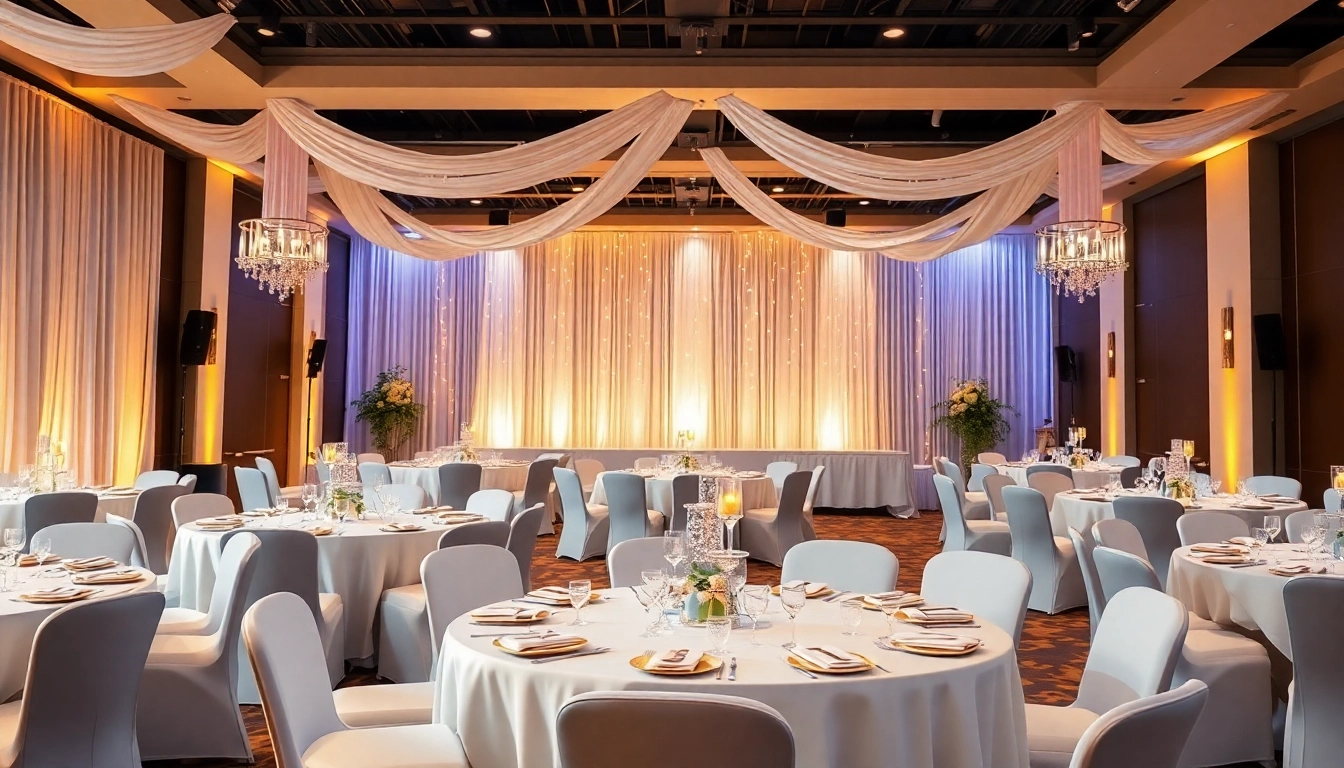Understanding Event Space Requirements
When planning an event, whether it’s a corporate gathering, a wedding, or a community celebration, choosing the right event space is paramount to its success. The selection of the venue can influence not only the logistics but also the tone and atmosphere of the entire event. Understanding your specific needs is the first step to finding the perfect space. This section will guide you through identifying your event needs, considering capacity requirements, and recognizing essential amenities.
Identifying Your Event Needs
Before you dive into searching for an event space, take the time to outline your goals. Ask yourself the following questions:
- What type of event are you hosting?
- What is the theme or purpose of the event?
- How many guests are you expecting?
- What is the desired atmosphere or experience for attendees?
Deciding on these factors will streamline your search. For example, a formal conference will require different features than a casual meetup. Establishing your objectives sets a clear direction for your venue selection.
Capacity Considerations for Event Space
Capacity is a crucial factor when selecting an event space. You’ll need a venue that can comfortably accommodate your guest list, preventing overcrowding or empty spaces that can dampen the event’s atmosphere. A good rule of thumb is to have about 10 square feet per attendee for seated events and 5 square feet per person for standing receptions. This calculation ensures that your guests have adequate room to move and interact.
Additionally, consider the layout of the space. Different configurations such as theater, classroom, or round-table setups may influence how many people you can fit into the venue while still maintaining comfort and accessibility. Always verify the specific layout options available in your chosen space.
Essential Amenities for Your Event Space
Each event has its set of requirements, and the right event space will typically come equipped with certain essential amenities:
- Audio-Visual Equipment: Access to projectors, screens, microphones, and sound systems can enhance presentations and entertainment.
- Internet Connectivity: High-speed Wi-Fi is critical for events that require presentations, streaming, or engaging audiences through social media.
- Catering Options: Determine if you will be providing food and drinks or if the venue has partnered with local caterers.
- Parking Facilities: Ample parking space or public transportation access can significantly affect your guests’ experience.
- Accessibility Features: Ensure the venue is equipped for guests with disabilities, including ramps, elevators, and accessible restrooms.
Exploring Different Types of Event Spaces
The spectrum of available event spaces ranges from corporate environments to distinctive venues, each tailored to suit specific occasions. This section will categorize these spaces into types and explore their unique advantages.
Corporate vs. Social Event Space
Corporate events, such as meetings, conferences, and team-building activities, often require professional environments that promote productivity. These spaces tend to feature boardrooms, conference halls, and tech-ready auditoriums. They may offer services like catering, tech support, and event planning services.
On the other hand, social event spaces are usually more versatile. They can be traditional banquet halls or unique venues like art galleries, lofts, or gardens. These spaces often emphasize aesthetics and adaptability, allowing hosts to mold the venue to fit the theme of their event.
Indoor and Outdoor Event Space Options
Another key consideration is whether to choose an indoor or outdoor setting. Indoor event spaces offer control over lighting and climate, making them suitable for formal gatherings, seminars, and presentations. They also provide the advantage of having dedicated facilities like restrooms and kitchens within easy reach.
Outdoor event spaces, however, bring natural beauty and can create a relaxed atmosphere that is ideal for informal gatherings, weddings, and festivals. When selecting an outdoor venue, consider factors such as weather, availability of cover, and access to restroom facilities.
Unique and Unconventional Event Spaces
For those looking to make a lasting impression, unique venues like museums, zoos, or historic buildings can provide a one-of-a-kind backdrop. These unconventional spaces are often full of character and charm, instantly enriching the guest experience. When considering such spaces, it’s essential to ensure they meet your logistical needs while also being engaging and memorable.
Best Practices for Booking an Event Space
Once you have a clear understanding of your needs and have explored your options, it’s time to dive into the booking process. This section will outline the best practices for evaluating listings, negotiating terms, and understanding policies.
How to Evaluate Event Space Listings
When evaluating potential event spaces, create a checklist based on your previously established needs. Key factors to assess include:
- Location: Is it easily accessible for your guests?
- Amenities: Does the space provide all essential features?
- Price: Does it fit within your budget, and what does that price include?
- Reviews: Look for testimonials or ratings from past events at the venue.
Requesting a walk-through or virtual tour can give you a better feel for the space and its suitability.
Negotiating Terms and Pricing for Event Space
Don’t hesitate to negotiate prices and terms with the venue owner or management. Understanding what is included in the rental fee (like tables, chairs, or AV equipment) can significantly impact your budget. Additionally, inquire about off-peak discounts or package deals that might save you money.
Establish clarity on payment schedules and cancellation fees. Ensure all agreements are put in writing to safeguard both parties’ interests.
Understanding Cancellation Policies in Event Space Booking
It’s critical to be fully aware of the cancellation policies of your chosen event space. Most venues will have their policies regarding refunds, credits, and rescheduling. Ensure you read the fine print and clarify any ambiguities before signing the contract.
Designing an Inviting Event Space
Once your space is booked, the next step is to transform it into an inviting and effective setting for your gathering. This section delves into themes, décor, layout, and lighting considerations.
Choosing Themes and Decor for Your Event Space
Themed décor can significantly elevate your event, reinforcing the purpose of the gathering while engaging guests visually. When considering themes, align with your audience’s interests and the overall message of the event. For instance, a tech conference might benefit from sleek, modern designs, while a wedding might embrace floral elegance.
Selecting the right color palette and decorations helps set the tone and atmosphere. Utilize elements such as table centerpieces, banners, and lighting to mirror your theme throughout the venue.
Layout and Seating Arrangements for Effectiveness
Layout is crucial to accommodating the type of event you are hosting. For example, a seated dinner requires different arrangements than a networking event. Considerations should include:
- Visibility: Ensure all guests can see and hear speakers or presentations.
- Flow: Arranging seating to facilitate movement can enhance networking opportunities.
- Comfort: Provide adequate space between tables or chairs to allow easy passage for guests and staff.
Lighting Considerations to Enhance Your Event Space
Proper lighting can transform an ordinary venue into an extraordinary setting. Use different types of lighting to enhance mood and focus:
- Ambient Lighting: Provides general illumination.
- Task Lighting: Highlights specific areas such as stages or dining areas.
- Accent Lighting: Adds drama, showcasing décor elements or centerpieces.
Consider natural lighting where possible, as it can create a warm and inviting atmosphere. However, ensure you have backup options if your event extends into the evening or cloudy days.
Maximizing Experience in an Event Space
After designing the environment, focus on maximizing the overall experience for your guests. This section discusses the importance of entertainment, food and beverage options, and post-event follow-ups.
Engaging Entertainment Ideas for Event Space
Entertainment can serve as a central component of your event, keeping guests engaged and encouraging participation. Based on the type of event, consider these ideas:
- Live Performances: Musicians, speakers, or performers can capture attention and elevate atmosphere.
- Interactive Activities: Activities such as photo booths, games, or workshops can keep guests entertained and involved.
- Professional Hosts or MCs: Engaging hosts can help guide the event and fill any downtime with humor or information.
Food and Beverage Options for Your Event Space
Food and beverages are often central to guests’ experiences. Consider how to best cater to your audience’s preferences. Will you offer buffet-style, plated meals, or food stations? Remember to account for dietary restrictions and preferences. Providing a variety of options can ensure everyone is accommodated.
Additionally, think about how to serve drinks. A cocktail bar, coffee station, or wine tastings can add a unique touch to the experience.
Post-Event Actions to Follow Up with Guests
The event may conclude, but the engagement shouldn’t stop there. Follow-up is crucial to maintaining relationships and gathering feedback. Consider sending thank-you notes, surveys, or recap emails that share highlights from the event. This strengthens connections and provides insights for future gatherings.
In conclusion, successfully planning and executing an event requires a comprehensive understanding of event space requirements, types, and best practices. By following the steps outlined in this guide, you’ll not only choose the right venue but also create a memorable experience for all your guests.



